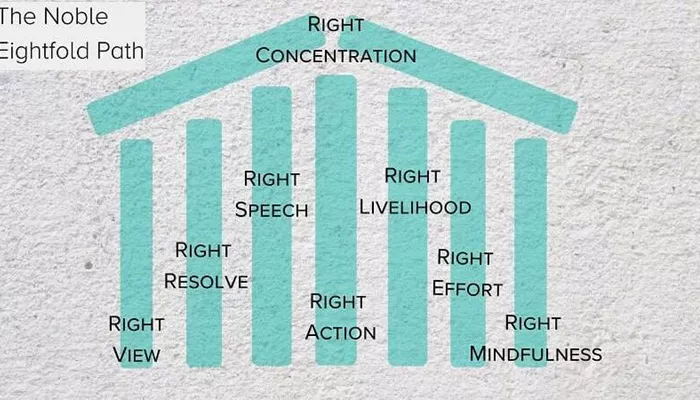The Eightfold Path is a central concept in Buddhism. It is a path to end suffering and reach enlightenment. However, many people ask, “Is there an Eightfold Path in Taoism?” The answer is not simple. Taoism and Buddhism are different religions. But they have shared ideas. This article will explain the Eightfold Path in Buddhism and explore if a similar path exists in Taoism. We will use simple words and clear ideas to help you understand.
Understanding the Eightfold Path in Buddhism
What is the Eightfold Path?
The Eightfold Path is a guide for living. It teaches people how to act, think, and live in peace. It is part of the Four Noble Truths in Buddhism. The goal is to end suffering (dukkha) and reach Nirvana. The path has eight parts. They are:
1. Right View
Understand that life has suffering. Know that everything changes. Accept that actions have results (karma).
2. Right Intention
Think with kindness. Avoid hurting others. Let go of anger and desire.
3. Right Speech
Speak the truth. Do not lie. Avoid gossip or hurtful words.
4. Right Action
Do good deeds. Avoid killing, stealing, or harming others.
5. Right Livelihood
Choose a job that does not hurt others. Avoid work that deals with weapons, harm, or lies.
6. Right Effort
Try to stop bad thoughts. Grow good thoughts. Stay focused and steady.
7. Right Mindfulness
Be aware of your body, feelings, and thoughts. Live in the present moment.
8. Right Concentration
Practice deep meditation. Train the mind to be calm and focused.
These eight steps help people follow the eightfold path religion in daily life.
Eightfold Path and Symbols
The Eightfold Path is often shown as a wheel with eight spokes. Each spoke stands for one part of the path. This symbol reminds Buddhists to stay balanced in their practice. You can learn more about the eightfold path symbol on trusted websites.
Does Taoism Have an Eightfold Path?
Key Ideas in Taoism
Taoism is a religion and philosophy from China. It teaches people to live in harmony with the Tao (also spelled Dao). The Tao means “the Way.” It is the natural flow of the universe. Taoism does not have an Eightfold Path like Buddhism. But it has similar values. These include:
- Living simply
- Following nature
- Being humble
- Letting go of desires
Laozi and the Tao Te Ching
Laozi (also spelled Lao Tzu) wrote the Tao Te Ching, a key Taoist text. It has 81 short chapters. These chapters talk about how to live wisely and with peace. Laozi teaches that forcing things leads to problems. Instead, people should flow with life like water.
Zhuangzi and Inner Peace
Zhuangzi was another Taoist teacher. He told stories to show how people can be free from stress. He believed in letting go of control. He said people suffer when they try to change things that cannot be changed.
Comparing the Eightfold Path with Taoist Teachings
Similar Values
Even though Taoism has no Eightfold Path, both religions share values. Here are a few:
- Right Intention and Taoist Simplicity: Both teach people to let go of greed and anger.
- Right Action and Non-Harming: Taoism also values not harming others.
- Right Mindfulness and Living in the Moment: Taoists believe in being present and aware, just like Buddhists.
Differences
There are also differences:
- Goal: Buddhism aims for enlightenment and the end of rebirth. Taoism aims for harmony with the Tao.
- Practice: Buddhism has strict rules and steps. Taoism is more flexible and natural.
Why People Confuse the Two
In China, many people followed both Buddhism and Taoism. This mixing is called syncretism. Over time, ideas from Buddhism and Taoism blended. Some temples teach both. Some people follow both paths. This is why many think the Eightfold Path is in Taoism. But in truth, it is not.
The Eightfold Path’s Influence on Taoism
Later Developments
During the Tang Dynasty, Chinese Buddhism became strong. Some Buddhist ideas influenced Taoism. Taoist monks even began using meditation like Buddhists. But Taoism kept its own identity. It never fully adopted the Eightfold Path.
Modern Taoist Practice
Today, some Taoist teachers use Buddhist terms. They may talk about “right action” or “mindfulness.” But these ideas are reshaped through Taoist thinking. They are more about flowing with life than following steps.
How to Follow Taoist Wisdom
Live Simply
Like the Eightfold Path teaches simplicity, Taoism also says to live with less. Do not chase money or power. Be happy with what you have.
Accept the Natural Flow
Taoists believe that nature has its own way. People should not fight it. If you are angry, take a breath and wait. Life changes. Things will pass.
Be Gentle
Taoism teaches softness. Water is soft but strong. It moves around rocks. In life, be like water. Stay calm and kind, even in hard times.
Conclusion
The Eightfold Path is not part of Taoism. It comes from Buddhism. But both religions teach us to live better lives. They ask us to be kind, aware, and balanced. Even if Taoism has no exact Eightfold Path, its teachings are full of wisdom.
Conclusion
Whether you follow the teachings of the Buddha or the Tao, the goal is similar. Live well. Do no harm. Stay in the moment. Both paths offer peace. They guide people to inner calm and true happiness. Understanding both can help you grow in spirit and live in harmony with the world.

